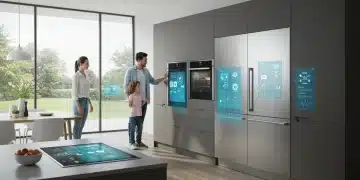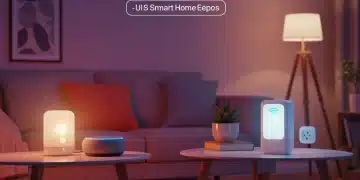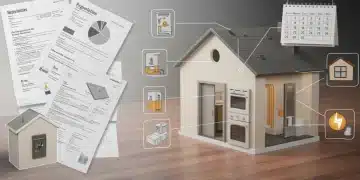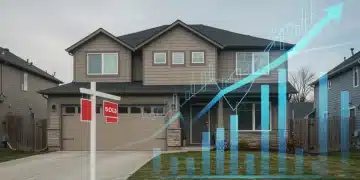Smart Home Energy Audits: 20% Savings for US Homes
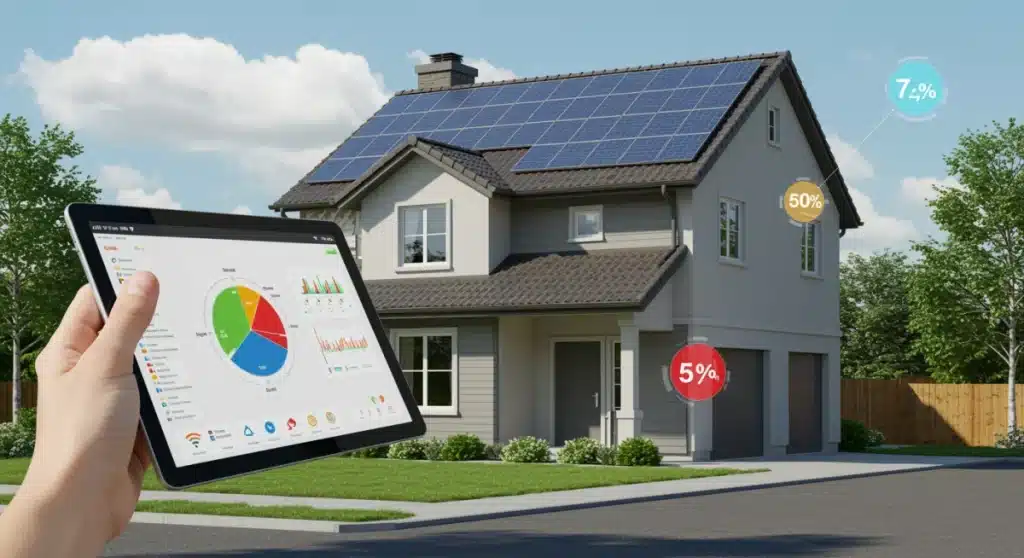
Smart Home Energy Audits are currently empowering US homeowners to pinpoint and achieve an average of 20% savings on their energy expenditures, leveraging cutting-edge technology for enhanced financial and environmental benefits.
As of late, a significant shift is underway in how US households manage their energy consumption. The latest data indicates that Smart Home Energy Audits: Identifying 20% Savings Opportunities in US Homes (FINANCIAL IMPACT) is no longer a futuristic concept but a present reality, offering tangible financial benefits. Are you aware of the substantial savings your home could be missing?
The Rise of Smart Home Energy Audits
The landscape of residential energy management is rapidly evolving, driven by advancements in smart home technology. Homeowners across the US are increasingly adopting integrated systems that go beyond basic automation, now focusing on granular energy monitoring and optimization. This trend marks a pivotal moment for identifying and addressing energy inefficiencies.
These sophisticated audits utilize a network of interconnected devices to collect real-time data on energy usage patterns. From smart thermostats to intelligent lighting and appliance monitors, these systems provide a comprehensive overview that traditional audits simply cannot match. The immediate availability of this data allows for prompt adjustments and a clearer understanding of where energy is being consumed, or wasted.
What Defines a Smart Energy Audit?
A smart energy audit differs significantly from its conventional counterpart by leveraging continuous data collection and analysis. Instead of a one-time assessment, it provides an ongoing, dynamic picture of a home’s energy performance.
- Real-time Data: Continuous monitoring of electricity, gas, and water usage.
- Device Integration: Connecting various smart devices for a holistic view.
- AI-Powered Analysis: Using algorithms to identify anomalies and suggest optimizations.
- Personalized Recommendations: Tailored advice based on specific household habits and home characteristics.
The integration of artificial intelligence (AI) is particularly crucial, as it allows these systems to learn and adapt to household routines, making predictive recommendations for energy conservation. This level of personalization ensures that suggested changes are not only effective but also minimally disruptive to daily life.
Identifying the 20% Savings Opportunity
Recent reports highlight that US homeowners are consistently identifying an average of 20% in potential energy savings through smart home energy audits. This figure, often considered a benchmark, represents a significant financial relief for many households facing rising utility costs. The ability to pinpoint specific areas of waste is key to achieving these reductions.
These savings are not merely theoretical; they are being realized through a combination of actionable insights and proactive adjustments. For instance, an audit might reveal that an HVAC system is operating inefficiently during certain hours, or that specific appliances are drawing phantom power. Armed with this knowledge, homeowners can make informed decisions to upgrade, repair, or simply adjust usage patterns.
Key Areas for Savings
The 20% savings often stem from improvements in several common household energy culprits. Understanding these areas is the first step towards optimization.
- HVAC Systems: Heating, ventilation, and air conditioning typically account for the largest portion of home energy consumption.
- Water Heating: Second only to HVAC, water heaters are often inefficient, especially older models.
- Lighting: Transitioning to LED and utilizing smart lighting controls can yield substantial savings.
- Appliances & Electronics: Identifying energy-hungry devices and reducing phantom load are crucial.
Beyond these primary areas, smart audits also uncover less obvious energy drains, such as poor insulation, leaky windows, or inefficient building envelopes. Addressing these structural issues can lead to long-term, sustained energy reductions, further enhancing the financial impact for homeowners. The data collected provides the evidence needed to prioritize these improvements effectively.
Financial Impact for US Homeowners
The financial implications of achieving a 20% reduction in energy consumption are substantial for US homeowners. For a typical household with an average annual energy bill of $2,000, a 20% saving translates to $400 back in their pockets each year. Over a decade, this accumulates to $4,000, representing a significant return on investment for smart home technology and audit services.
Moreover, these savings are not just a one-time benefit. They are ongoing, providing continuous relief from utility expenses. In an era of economic uncertainty and fluctuating energy prices, such predictable savings offer a valuable buffer for household budgets. The initial investment in smart home devices and an energy audit often pays for itself within a few years, making it a financially prudent decision.
Beyond Direct Savings: Property Value and Incentives
The financial benefits extend beyond direct utility bill reductions. Enhancing a home’s energy efficiency can also positively impact its market value and eligibility for various incentives.
- Increased Property Value: Energy-efficient homes are increasingly attractive to buyers, often commanding higher prices.
- Government Incentives: Many federal, state, and local programs offer tax credits, rebates, or grants for energy-efficient upgrades.
- Reduced Maintenance Costs: Optimizing systems often leads to less wear and tear, reducing repair expenses.
- Insurance Discounts: Some insurers offer lower premiums for homes with advanced smart monitoring and security features.
These indirect financial advantages further underscore the comprehensive value proposition of undertaking a smart home energy audit. Homeowners are not just saving money on bills; they are investing in the long-term financial health and asset value of their property.
Technological Innovations Driving Efficiency
The rapid pace of technological innovation is at the heart of the effectiveness of smart home energy audits. New sensors, advanced algorithms, and enhanced connectivity are continually improving the accuracy and actionable insights these systems provide. The evolution of the Internet of Things (IoT) has been particularly instrumental, enabling seamless communication between diverse devices.
From predictive analytics that anticipate peak usage times to self-learning thermostats that adjust based on occupancy, the sophistication of these tools is growing. Machine learning models can now identify subtle patterns of energy waste that would be impossible for human observation, offering precise recommendations for optimization. This continuous improvement ensures that audits remain relevant and effective as energy demands and technologies change.
Key Smart Home Technologies
A suite of technologies converges to make comprehensive smart energy audits possible, each playing a crucial role in data collection and analysis.
- Smart Thermostats: Devices like Nest and Ecobee learn preferences and optimize heating/cooling schedules.
- Energy Monitors: Whole-home or individual appliance monitors track consumption in real-time.
- Smart Lighting: Dimmers, motion sensors, and scheduling reduce unnecessary electricity use.
- Smart Plugs: Control and monitor the energy consumption of individual devices.
- Integrated Platforms: Centralized hubs that connect and manage all smart devices, providing a unified energy dashboard.
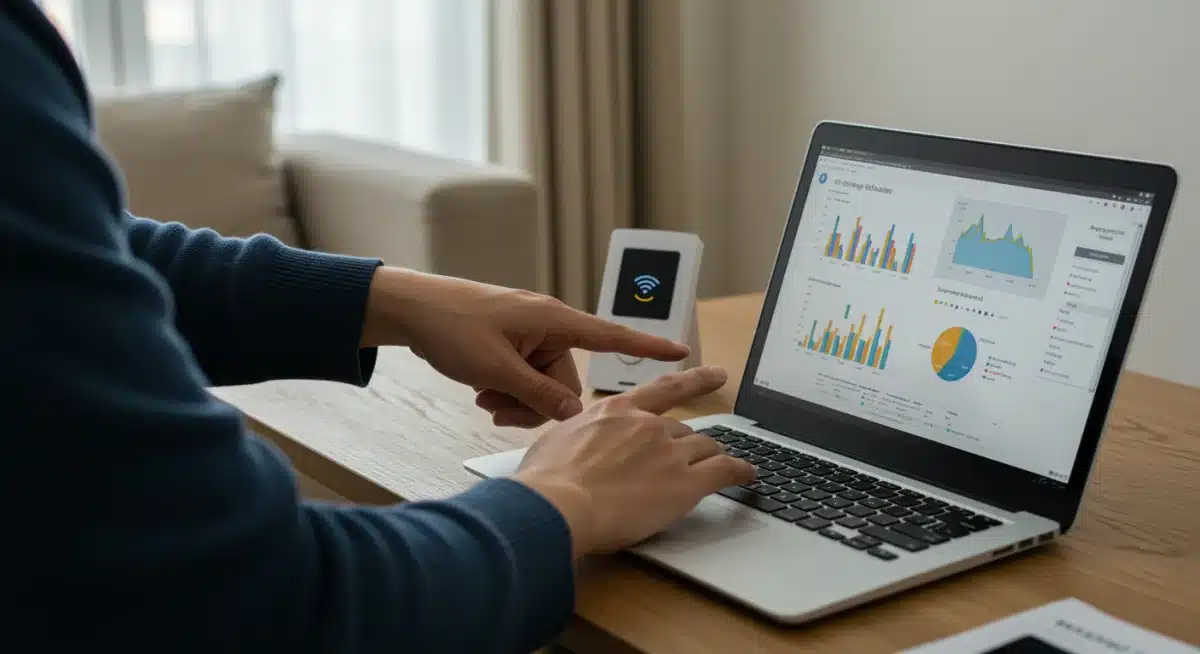
These technologies are becoming more user-friendly and affordable, making them accessible to a broader range of homeowners. The interoperability between different brands and platforms is also improving, allowing for more integrated and powerful energy management solutions. This accessibility is critical for widespread adoption and achieving significant national energy savings.
Implementation Strategies for Homeowners
For US homeowners looking to capitalize on the 20% savings opportunity, a strategic approach to implementing smart home energy audits is essential. It’s not just about installing devices; it’s about understanding the data and making informed decisions. The process typically begins with an initial assessment, followed by phased implementation and continuous monitoring.
Starting small can be an effective strategy, focusing on high-impact areas like smart thermostats or energy monitoring plugs for major appliances. As homeowners become more familiar with the technology and see initial savings, they can gradually expand their smart home ecosystem. Education and resources from energy providers or certified auditors can also play a vital role in guiding these implementation efforts.
Steps to a Successful Smart Audit
A structured approach ensures that homeowners maximize their investment and achieve optimal energy savings.
- Initial Assessment: Understand current energy usage and identify potential problem areas.
- Device Selection: Choose smart devices that align with specific needs and budget.
- Professional Installation: Ensure proper setup and integration of all smart home components.
- Data Analysis & Action: Regularly review audit reports and implement recommended adjustments.
- Ongoing Monitoring: Continuously track performance and fine-tune settings for sustained efficiency.
Many utility companies and government programs offer resources, sometimes even subsidized audits, to encourage homeowners to adopt energy-efficient practices. Leveraging these resources can further reduce the initial cost of implementation and accelerate the return on investment. The key is to view the audit not as a one-time event, but as an ongoing process of optimization.
Future Outlook: Scaling Energy Efficiency
The future of smart home energy audits in the US looks promising, with increasing adoption rates and continuous technological advancements. Experts predict that the average 20% savings opportunity could even grow as AI and machine learning capabilities become more sophisticated, offering even finer-grained control and predictive insights. The push towards smart grids and renewable energy sources will also integrate seamlessly with these home-based systems, creating a more resilient and efficient energy infrastructure.
Wider policy support and public awareness campaigns are expected to further accelerate the adoption of these technologies. As more homeowners experience the tangible financial and environmental benefits, smart home energy audits are poised to become a standard practice rather than a niche offering. This scaling of energy efficiency at the residential level will have a profound impact on national energy consumption and sustainability goals.
Challenges and Opportunities
While the outlook is positive, certain challenges and opportunities will shape the trajectory of smart home energy audits.
- Data Privacy Concerns: Ensuring the security and privacy of energy consumption data is paramount.
- Interoperability Standards: Developing universal standards for device communication will enhance user experience.
- Consumer Education: Raising awareness about the benefits and how to effectively utilize smart systems.
- Investment Costs: Making advanced systems more affordable and accessible to all income levels.
Addressing these challenges will unlock even greater potential for smart home energy audits. The opportunity lies in creating a future where energy efficiency is not just a goal but an inherent feature of every home, driven by intelligent technology and informed homeowner choices. The ongoing developments suggest a future where 20% savings are just the beginning.
| Key Point | Brief Description |
|---|---|
| 20% Savings Opportunity | US homeowners can achieve an average of 20% reduction in energy bills through smart home audits, translating to significant annual savings. |
| Smart Audit Technology | Leverages AI, IoT devices, and real-time data to provide granular insights into energy consumption and waste. |
| Financial & Indirect Benefits | Beyond bill reduction, audits increase property value and qualify homes for various government incentives and rebates. |
| Strategic Implementation | Homeowners should adopt a phased approach, starting with high-impact areas and continuously monitoring for optimal results. |
Frequently Asked Questions About Smart Home Energy Audits
A smart home energy audit uses interconnected devices and AI to continuously monitor, analyze, and optimize your home’s energy consumption. Unlike traditional audits, it provides real-time data and personalized recommendations for efficiency improvements, helping identify precise areas of waste.
Current data indicates that US homeowners can realistically identify and achieve an average of 20% savings on their annual energy bills. This figure can vary based on your home’s initial efficiency, local climate, and the extent of improvements implemented after the audit.
Key technologies include smart thermostats, whole-home energy monitors, smart plugs, intelligent lighting systems, and integrated platforms that connect and process data from all these devices. AI and machine learning algorithms are crucial for data analysis and optimization suggestions.
Yes, many federal, state, and local governments offer various incentives, including tax credits, rebates, and grants, for homeowners who invest in energy-efficient upgrades. It’s advisable to check with your local utility provider and government websites for applicable programs in your area.
The return on investment (ROI) for smart home energy systems can vary, but many homeowners report recouping their initial investment within a few years due to significant savings on utility bills. Factors like the cost of devices and the extent of energy waste before the audit influence the timeline.
What Happens Next
As smart home technology continues its rapid advancement, the focus will undoubtedly shift towards even greater integration and predictive capabilities. Expect to see more seamless connections between home systems and utility providers, potentially leading to dynamic pricing models that reward real-time energy conservation. Policy discussions around universal interoperability standards and data privacy will also intensify, aiming to foster a more secure and user-friendly ecosystem. The ongoing developments suggest that the 20% savings identified today are merely a baseline, with future innovations poised to unlock even greater financial and environmental benefits for US homeowners.

